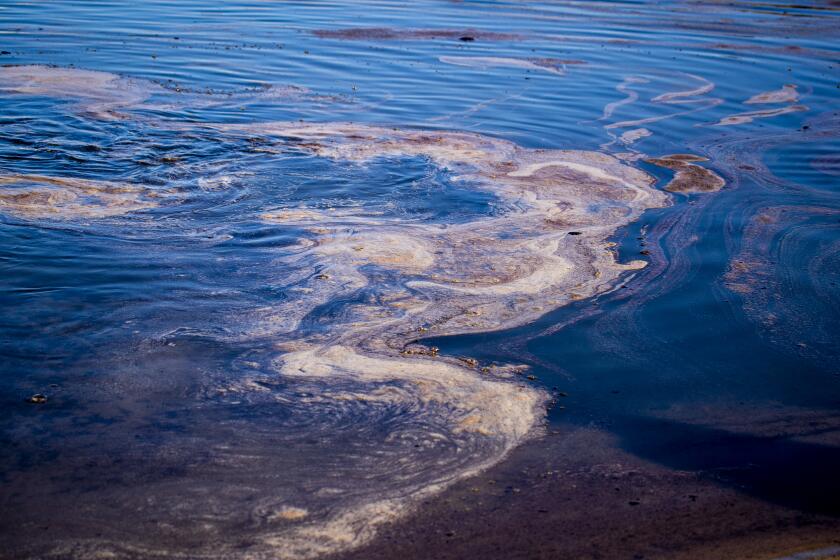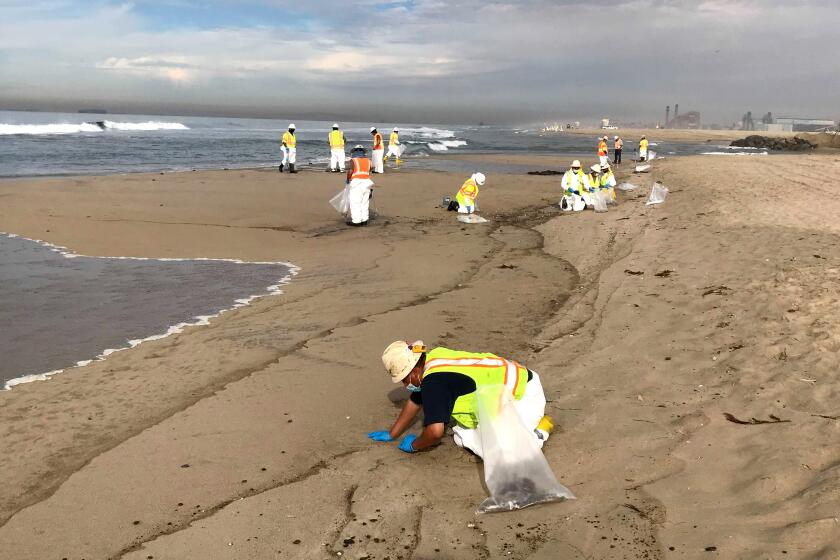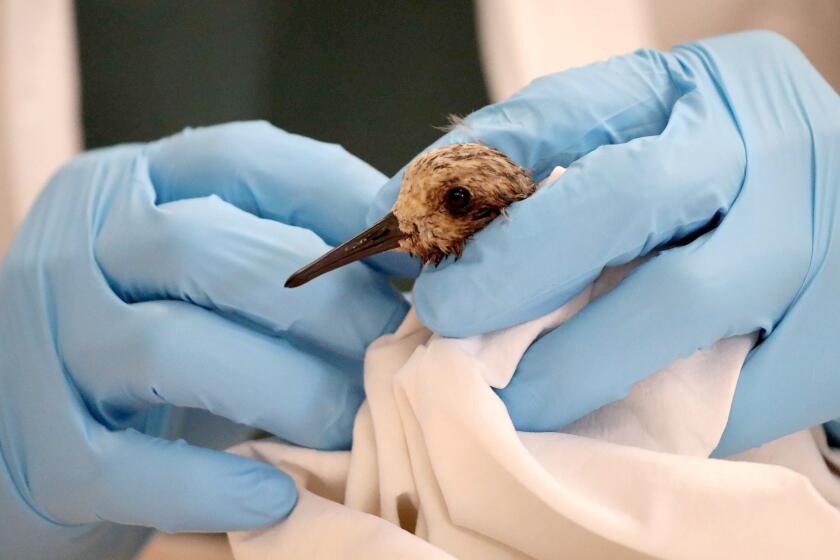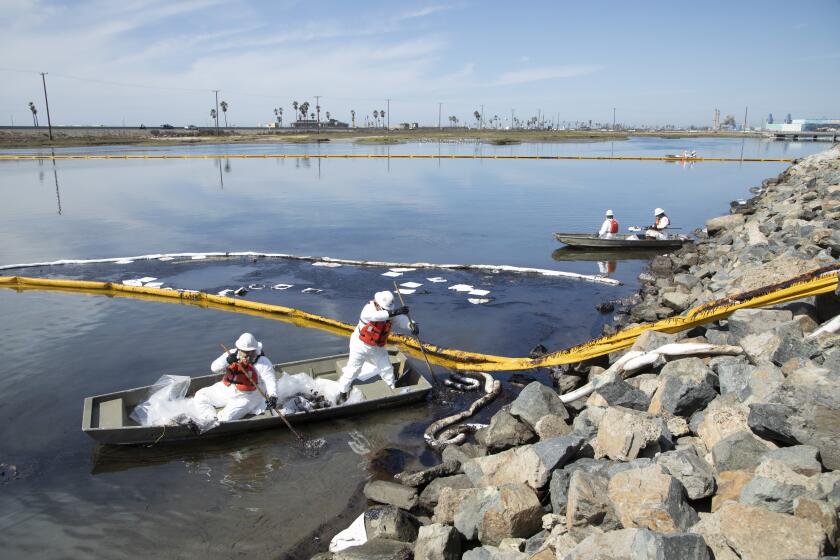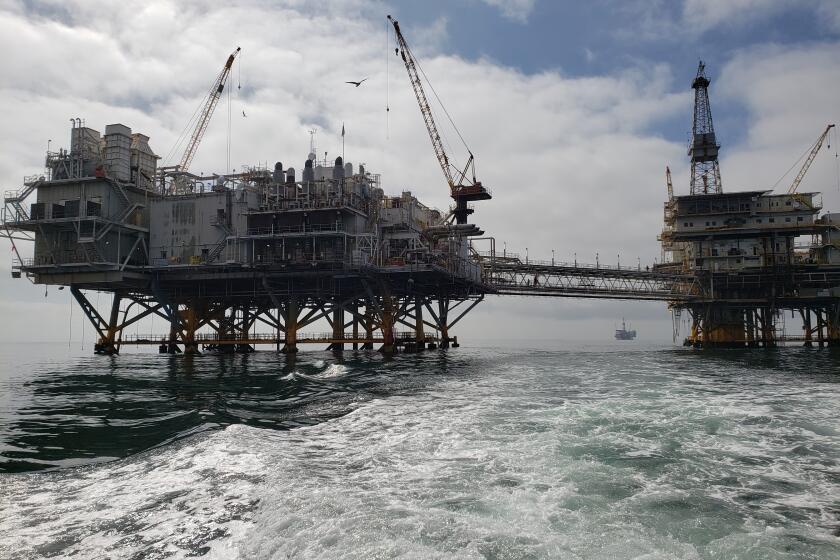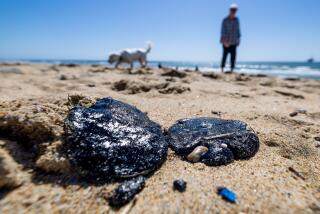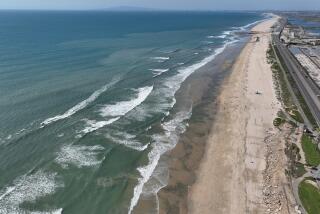Newsom declares emergency as investigators probe whether anchor caused O.C. oil spill
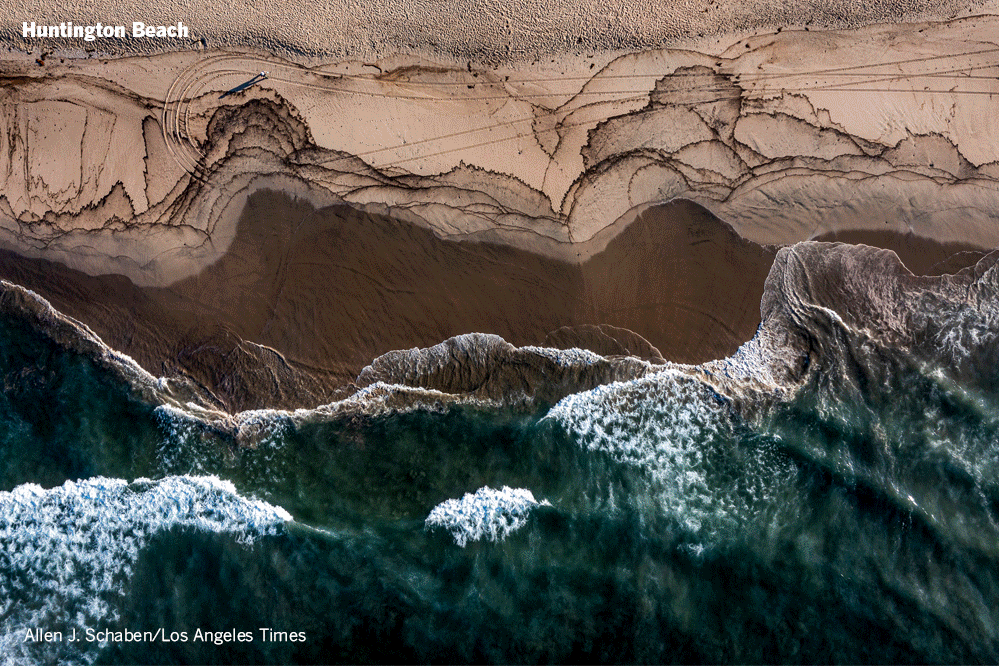
The Coast Guard is investigating whether a large commercial ship set anchor in the wrong location, damaging an oil pipeline and causing the massive Orange County oil spill, an official familiar with the investigation told The Times Monday.
The anchor dragged the pipeline as much as 150 feet, the official said. Vessels are given anchor points in order to avoid pipelines. Coast Guard investigators are examining whether the ship’s captain was aware of the dragging. The source spoke on the condition of anonymity.
Earlier Monday, Martyn Willsher, president and chief executive of the pipeline operator’s parent company, said that a ship’s anchor striking the pipeline was “one of the distinct possibilities” for the spill.
“We have examined more than 8,000 feet of pipe and we have isolated one specific area of significant interest,” Willsher, the Amplify Energy Corp. executive, told reporters. “There’s more information to come, but I think we’re moving very closely to the source and the cause of this incident.”
The focus on a ship’s anchor came as officials up and down the Orange County coast kept watch on a large portion of the oil that had not yet reached shore, while crews worked furiously to contain the spread, employing booms and at times scooping oil up by hand from polluted beaches. Wildlife rescuers cared for animals coated in goo.
Late Monday, Gov. Gavin Newsom declared a state of emergency in Orange County to help with the clean-up efforts.
“The state is moving to cut red tape and mobilize all available resources to protect public health and the environment,” Newsom said in a statement. “As California continues to lead the nation in phasing out fossil fuels and combating the climate crisis, this incident serves as a reminder of the enormous cost fossil fuels have on our communities and the environment.”
The spill, first reported Saturday morning, originated from a pipeline running from the Port of Long Beach to an offshore oil platform known as Elly. The failure caused roughly 126,000 gallons of oil to gush into the Catalina Channel, creating a slick that spanned about 8,320 acres.
The spill has left crude along stretches of sand in Newport Beach, Laguna Beach and Huntington Beach, killing fish and birds and threatening ecologically sensitive wetlands in what officials are calling an environmental catastrophe.
The oil will likely continue to encroach on Orange County beaches and environmentally sensitive habitats for the next few days, officials said.
U.S. Rep. Mike Levin (D-San Juan Capistrano) said at a news conference Monday night that oil was making its way into his district, which includes southern Orange County and northern San Diego County. Officials saw oil at Dana Point Harbor, he added.
“There is no offshore drilling that is truly safe,” Levin said, adding that he’d introduced legislation to ban all offshore drilling.
Cargo ships heading to the ports in Los Angeles and Long Beach frequently pass through the area where the spill occurred, officials said. During the pandemic, Southern California waters have seen gridlock as dozens of container ships at a time wait to get into the ports. It was unclear, however, how close those containers have been to the offshore oil systems.
Experts said investigators will need to inspect the pipeline and will have ample data to draw on in determining whether an anchor caused the spill — and if so, which ship it was.
The Marine Exchange of Southern California functions like a nautical version of air-traffic control, directing cargo ships to anchor at designated anchorages and tracking all vessels entering and leaving the ports, said James Fawcett, an adjunct professor of environmental studies at USC who is an expert in coastal regulations and ports.
Each anchorage is mapped with a circle around it so that the ship has enough space to swing around in the wind, he said. “Recently there have been times when the established anchorages were full and the Marine Exchange assigned ships into boxes that are further out in the harbor, further out to sea, that are not designated anchorages on the chart.”
The electronic charts that are used by captains of commercial ships show all the known underwater hazards to avoid, such as internet cables, power lines and pipelines, said Steven D. Browne, a professor of marine transportation at California State University Maritime Academy in Vallejo.
The massive oil spill from a 126,000-gallon leak off the Orange County coast is moving south, threatening marine protected areas as well as popular beaches.
“As the captain is choosing a place to drop the anchor, the chart should be examined very carefully to make sure that it is a safe area,” Browne said. “It’s certainly a point of concern for a ship’s captain approaching an anchorage is, is it safe to drop the anchor at this particular spot?”
Browne said he isn’t familiar with specifics of the system at the ports of Los Angeles and Long Beach, such as how offshore anchorages are handled.
“I imagine with the congestion of ships waiting to get into L.A.-Long Beach, that ships are anchoring in places that they don’t usually do so, further off the coast. So perhaps that is related to this incident, if that is what happened,” Browne said.
Coast Guard officials are flying over the spill three to four times a day to map the oil’s direction and compare it with tides, currents and winds to project the potential impact on beaches south of Laguna in the coming days. County and local officials say they’re poised to close more of the coast and the Dana Point harbor, if necessary.
In Laguna Beach, residents woke up to clusters of oil washing up along the sand.
A major oil spill off the coast of Huntington Beach, Calif., washed up on nearby Orange County beaches, killing fish and birds and threatening local wetlands.
Larger, golf-ball-sized pieces of tar have washed up along Crescent Bay, a beach known for its distinctive cove that runs about a quarter-mile in length from where Cliff Drive intercepts North Coast Highway, and along Shaw’s Cove.
Two contracted oil-recovery vessels known as skimmers worked off the coast of Laguna Beach overnight to prevent as much of the oil from coming ashore as possible, said Kevin Snow, chief of marine safety for Laguna Beach.
“The entire city is a marine-protected area, which means we have sensitive marine habitat and wildlife here that is protected, and we need resources to protect this unique ecosystem,” Snow said.
A few miles north, Newport Beach officials closed the city’s recreational harbor Monday morning in an effort to stem the spread of the oil, city spokesman John Pope said.
“We don’t have oil in there right now, so a huge priority is keeping oil from getting into the harbor,” Pope said.
Softball-sized clumps have washed ashore between the mouth of the Santa Ana River and 52nd Street. Much of the slick remains about a quarter-mile offshore, Pope said.
A developing list of what Southern Californians can do to help with the O.C. oil spill.
In Huntington Beach, which bore the brunt of the oil incursion Sunday, crews deployed 2,050 feet of booms to try to stop further incursion and protect sensitive wildlife areas, including Talbert Marsh, a 25-acre ecological reserve across from Huntington State Beach that is home to dozens of species of birds.
County officials also built large sand berms in the area to keep ocean water and oil from continuing to flow into the habitat, which has already been breached by oil.
A 5½-mile stretch of sand in Huntington Beach from Seapoint Street near the Bolsa Chica wetlands to the Newport Beach city line remained closed as crews continued cleanup efforts.
Officials involved in the spill response believed as of Saturday evening that oil had reached the waters off San Diego County, according to materials obtained by The Times.
Along the shore early Monday workers in reflective vests combed through the sand — at times on their hands and knees — scooping up oil and placing it into trash bags.
Teams from the Oiled Wildlife Care Network were on the beach at first light combing the area around Bolsa Chica State Beach and south to Laguna Beach, both in the water and on land, said Michael Ziccardi, director of the Oiled Wildlife Care Network at UC Davis.
Officials found three oiled birds Sunday — a brown pelican, an American coot and a duck. The pelican had extensive injuries and had to be euthanized, he said. A fourth bird, a sanderling, was found Monday. There have also been multiple sightings of oiled gulls. The oiled birds were being treated at the Wetlands and Wildlife Care Center, city officials said.
Divers are completing an intricate inspection of the pipelines on the sea floor, about 80 to 100 feet below the ocean’s surface.
State wildlife officials announced a ban on fishing or collecting shellfish from Huntington Beach to Dana Point in the wake of the oil spill.
Rep. Michelle Steel (R-Seal Beach) sent a letter to Gov. Gavin Newsom on Monday urging him to join her efforts in requesting a major disaster declaration for Orange County from President Biden. She sent a letter to the president Sunday seeking the declaration, which, if approved, would make additional federal assistance available for state and local agencies and individuals affected by the spill.
Questions also continue to swirl from residents about how long the pipeline was leaking. California and federal officials had strong indications of oil on the water off the Huntington Beach coast Friday evening, records reviewed by The Times show, more than 10 hours before the operator of an oil platform reported it to authorities.
During a news conference Monday afternoon, Orange County Dist. Atty. Todd Spitzer said he was disappointed that Amplify Energy Corp.’s own divers were investigating the pipeline rupture. That task should be undertaken by an independent agency, he said.
“If that is not done independently, that is a travesty,” he said.
Amplify Energy Corp., the owner of the offshore oil operation, had recently emerged from bankruptcy, while a subsidiary amassed numerous federal noncompliance incidents.
At the news conference Monday night, Orange County Supervisor Katrina Foley said the Coast Guard and California Department of Fish and Wildlife are conducting their own investigation and will not rely on Amplify’s divers.
“We’re not going to rely on the company to investigate” itself, she said.
Times staff writers Anh Do, Robin Estrin and Gregory Yee contributed to this report.
More to Read
Sign up for Essential California
The most important California stories and recommendations in your inbox every morning.
You may occasionally receive promotional content from the Los Angeles Times.
